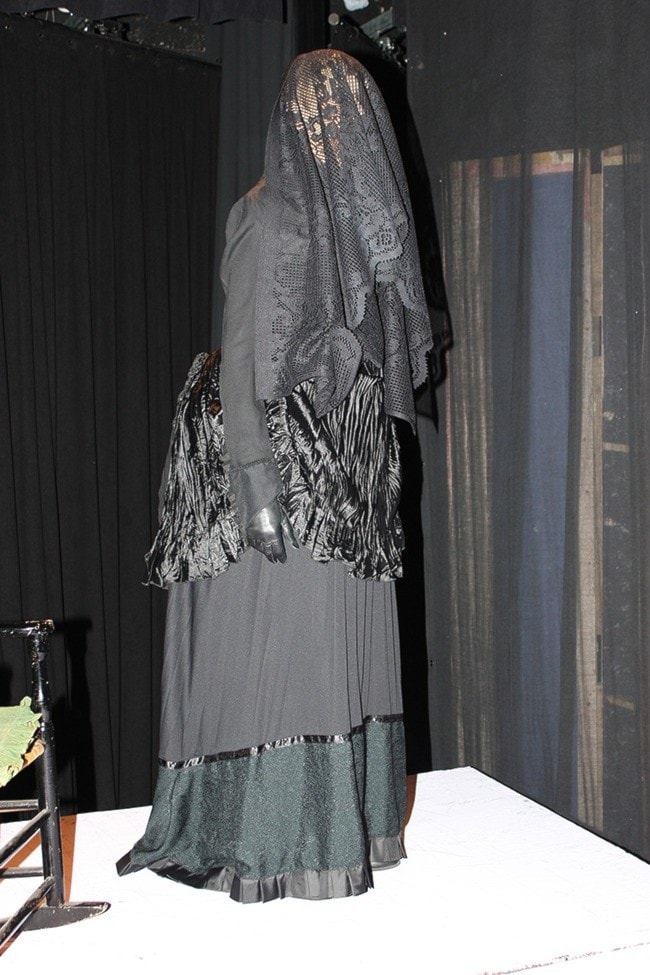There is nothing like a good old fashioned ghost story to get you in the mood for Halloween — the current Echo Players production delivers a classic with a few twists and surprises.
The Woman in Black is touted as a theatrical spine chiller that will have you on the edge of your seat the moment the curtain rises, but there is no need to avoid the Village Theatre if you are a scaredy-cat.
Opening night didn’t provoke screams or gasps from the audience and while the play didn’t come across as hair raising, it is definitely a theatrical rarity.
Directed by Sue Murguly, the play itself is captivating even without the fear factor.
With brilliant acting by the two main characters, the play relies on the art of good old fashioned story telling, the kind you might hear while sitting around a campfire.
With a few props and some sound effects, the play has just two main actors to create an illusion for the audience. In an age where the computer-generation has taken over, it’s refreshing to go back to basics.
There are no stunning costumes or lavish sets and the sound designer plays a huge role in bringing Victorian streets and galloping horses to life.
Although I was expecting a real nail biter I left the theatre with all of my finger nails intact and an appreciation for how difficult it is to create terror in live theatre.
Unlike the big screen where directors use editing and special effects to get your heart racing, stage directors must rely on the actors to incite chills.
The strength of this play comes from first rate performances by Gary Davey and Mort Paul both appearing by permission of Canadian Actors’ Equity Association.
The fact that there are only these two actors playing numerous characters makes the play very unique but the audience must fully engage their brain and imagination if they want to experience a ghostly night in the theatre.
The story starts out simply enough. The earnest young solicitor Arthur Kipps leaves cosmopolitan London for the mysterious Eel Marsh House in the remote town of Crythin Gifford.
He has been asked to attend the funeral of one of his firm’s clients, the reclusive Mrs. Alice Drablow, and finalize the dead woman’s affairs.
What he comes across, however, will leave its mark on him for years to come, and as an older, greyer man (Davey), he will turn to a bright-eyed Actor (Paul), bursting with charm and enthusiasm, to exorcise ghosts both emotional and real - through a retelling of his experience.
With a comic flare, Kipps and the actor banter back and forth about just how excruciating the long mumbled manuscript would be for an audience to endure. Finally, the actor convinces Kipps not only to turn the story into theatre, but also to let him, the actor, play the young Mr. Kipps of the story.
At first, the play seems to drag on as the two characters argue as to whether or not the retelling of The Woman in Black is possible but this is purposely and skilfully done to lull the audience into a false sense of security.
The elder Kipps begins the journey of reliving his past with great hesitation, but soon slips into the shoes of the host of colourful characters he encounters along the way with the hired Actor playing a younger version of himself.
Davey does a stellar job portraying the various characters Paul’s young Mr. Kipps encounters on his visit to the English Moor. From a snuffling clerk to a taciturn horseman, Davey makes each character unique allowing the audience to keep the story clear.
Paul has the challenge of transporting the audience into the scary house and he does so with highly engaging story telling.
The contrast between the characters of the actor, whose name is never stated, and the elder Kipps provides the audience with a glimpse into the past, so to speak, as the two roles slowly become inverted. The actor, who begins re-enacting the events of Kipps’ manuscript becomes more acquainted with the ghost of Kipps past than he is aware of.
With just hints, glimpses and suggestions on what is shadowy, heard and sometimes only half-seen including The Woman who is performed by Diane LeBlanc it is up to the audience to unravel the mystery.
The spirit of the show is a murky ghost story and is an ode to the art of storytelling and the theatre allowing those who accept the premise to be engaged.
